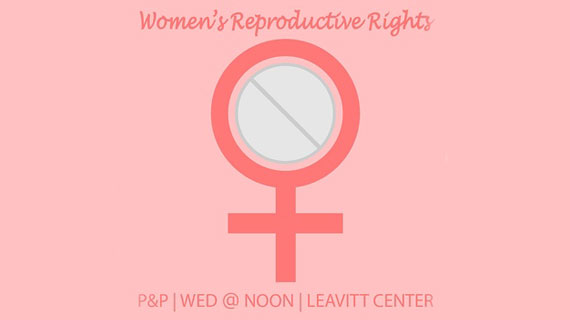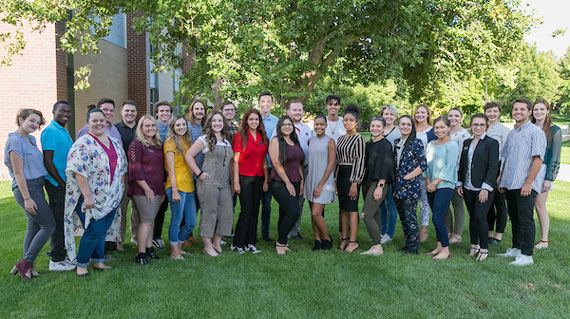Pizza and Politics- Women’s Reproductive Rights
Posted: April 25, 2018 | Author: Cami Mathews | Read Time: 4 minutes

The Michael O. Leavitt Center for Politics and Public Service hosts Pizza & Politics every Wednesday at noon to discuss a current political topic. Leavitt Center student employees research the topic and moderate the conversation. These discussions expose students to a variety of important issues and encourages them to share their own perspectives while learning all sides of an issue. Free pizza is provided for all who attend.
This week’s topic was moderated by Victoria Stephens, a freshman Political Science major with a minor in Psychology from Ogden, Utah, and Cynthia Hawk, a freshman from St. George, Utah, majoring in Graphic Design and minoring in Illustration. The discussion was on Women’s Reproductive Rights, ranging from birth control to Planned Parenthood services.
Basic information for the audience started with types of birth control: hormonal, blockade, emergency, and intrauterine. Types of each include pill, condoms, Plan B, and IUD. Currently under Obamacare, these four types are covered as well as sterilization, such as vasectomies, patient education and counseling.
How much access to birth control should be provided by the government?
The audience of Pizza & Politics became predictable throughout the semester. Conservative views steered away from more government interference, while liberal views felt it was the duty of the government to help women access birth control. A lot of voices did say that birth control should be accessible, but varied on the process. Some felt it should be at the corner stores or over the counter, others felt it should come from medical professionals but for a fraction of the current cost.
Thoughts on the range of services that Planned Parenthood provides?
Two sets of numbers from Planned Parenthood were explored prior to answering the question. The first set was from the eight Planned Parenthood clinics in Utah, only one of which offers abortion services. Here is 2017 by the numbers:
- STI testing and treatment - 50,368
- Cancer screenings and prevention - 15,508
- Pregnancy testing and information - 14,498
- Abortion - 1,957
- Vasectomies - 93
- Birth control - 248,825+
Planned Parenthood locations across America had the following 2017 numbers:
- STI testing and treatment - 47%
- STI, HIV, HPV, etc.
- Cancer screenings and prevention - 7%
- Breast exams, pap tests, etc.
- Contraception - 28%
- Vasectomies, IUD, oral pills, etc.
- Abortion - 3%
- Women’s health services - 14%
- Pregnancy tests, prenatal services, etc.
- Other services - 1%
- Adoption referrals, UTI treatments, etc.
A majority of the audience supported the services provided by Planned Parenthood. All opinions came down to abortion services, which narrowed to whether or not a woman should have the right to abort her pregnancy. A lot of people also spoke on behalf of male services at Planned Parenthood, saying there were not enough and they have room for expansion.
Is there a form of abortion that is more ethical than others?
In medicine, an abortion is the premature exit of products of conception (the fetus, fetal membranes, and placenta) from the uterus. There are different forms of abortion, three of which were discussed at Pizza & Politics:
- Non-surgical - pill taken in the first 2-10 weeks, stops development of pregnancy
- Vacuum Aspiration - 2-12 weeks, sucks fetus out
- Dilation and Evacuation - 13-22 weeks, dilated cervix, then suction is used
The abortion conversation had so many twists and turns it was difficult to track. To start, a lot of people said that abortion should not be allowed unless it is non-surgical in the first 2-10 weeks. However, many people pointed out cases where the mother’s life was in danger or when the woman was raped. The situations where the mother’s life is in danger may not be known until after the tenth week.
A lot of people, whether in favor of or against abortion, did agree that it is ultimately the woman’s choice. If the woman is going to abort the baby, it should be done safely with the help of medical professionals. The ethics of abortion vary from person to person, so it all comes down to the woman seeking the procedure.
Is there a compromise between pro-life and pro-choice?
To put it simply, the compromise starts with changing the idea that one must either be pro-life or pro-choice. Many said they are pro-life by worrying about the mother, but also pro-choice because that is her body and her decision. The room maintained civil dialogue throughout the hour and many left with new perspectives and insights.
For more information on the Leavitt Center, visit their web page.
This article was published more than 3 years ago and might contain outdated information or broken links. As a result, its accuracy cannot be guaranteed.
Tags: Leavitt Center Political Science




